Key points
- The pH scale shows how acidic a substance is. It can be measured using a pH meter which gives a numerical value.
- The pH scale ranges from 0 (very acidicA word which describes substances with pH values lower than 7. ) through 7 (neutralA substance that is not acidic or alkaline.) to 14 (very alkalineA word which describes substances with pH values higher than 7. ).
- pH can be also be measured using an indicator and comparing the colour with a comparison chart.
pH scale activity
Play this game to see where different common substances appear on the pH scale.
Do you think pure water is acidic, alkaline or neutral?
Pure water is neutral.
However, water comes from different sources, like tap water or river water. These water samples have other substances dissolved in them. They might show up as slightly acidic or slightly alkaline because of this.
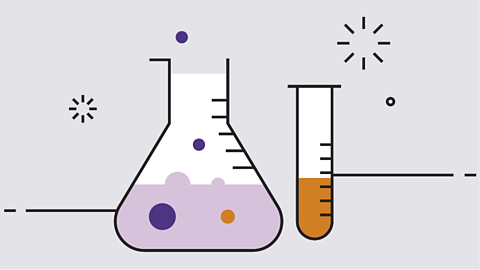
Video
Watch this video to find out more about the pH scaleA scale which gives a value for how acidic or alkaline a substance is. .
VOICEOVER: The pH scale
The pH scale measures how strongly acidic or alkaline a solution is using a set of values from pH 0 to pH 14.
When pure water is dropped into a solution of universal indicator, the indicator stays green. This indicates a pH value of 7 and tells us that water is neither alkaline or acid, but neutral.
Acidic solutions have pH values less than 7. Stomach acid turns universal indicator paper a strong red colour. This indicates a pH value of 0, the strongest value of acid.
Alkaline solutions have pH values more than 7. Toothpaste will turn universal indicator paper blue indicating a pH value of 9, which is a weak alkali.
What is used to find the pH of the substances in the video?
A universal indicator is used.
It gives different colours at different pH values in a rainbow pattern from 0 (red) to 14 (purple). The indicator comes in solution or paper forms.
The pH scale
The pH scale is a number scale from 0 to 14. It tells us how acidic or alkaline an aqueous solutionA solution made by dissolving a substance in water. is. The pH scale is used to classify solutionA mixture made when a solute (usually a solid) dissolves into a solvent (a liquid). Sea water is a solution of salt dissolved into water. as acidic, alkaline or neutral.
- Neutral solutions are exactly pH 7.
- Acidic solutions have pH values less than 7. The closer to pH 0, the more acidic a solution is.
- Alkaline solutions have pH values more than 7. The closer to pH 14, the more alkaline a solution is.

Did you know?
Everyday substances are not pure. This makes it difficult to give them a pH value. One type of soap might have a pH of 8, but another have a pH of 9.
Stomach acid has a range of pH values, depending on how long ago you last ate!

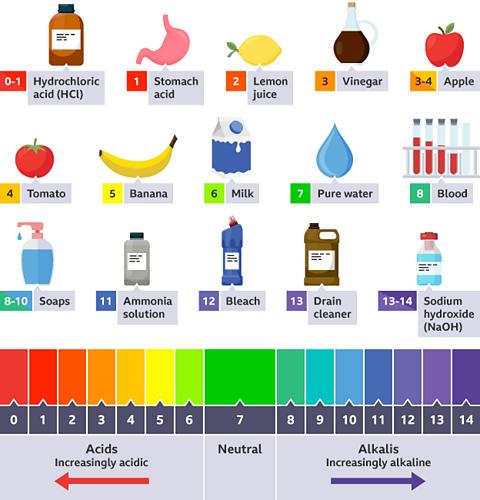
Solutions can be acidic, alkaline or neutral. For example, pure water is neutral with a pH of 7. A solution of common salt (sodium chloride) is also neutral, so it has a pH of 7 too.
In science we often use the term aqueous solution. It describes a solution that’s made of water. pH can only be measured in water-based solutions.
Therefore, we can measure a substance’s pH by dissolveThe process when a solute is mixed with a solvent and the solute breaks into much smaller particles and spreads out. it in water.
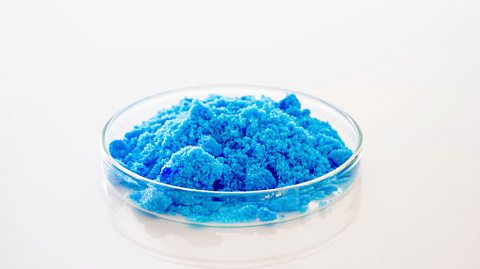
For example, copper sulfate is a solid in the form of blue crystals. When copper sulfate is dissolved in pure water, we can measure the pH of the solution. The pH is approximately 6 which shows that copper sulfate solution is slightly acidic.


A solution is a liquid made when a soluteThe solid (or occasionally a gas) which dissolves into a solvent (liquid) in order to make a solution. For example, the main solute in sea water is sodium chloride. is dissolved in a solventThe liquid in a solution which dissolves the solute. For example, the solvent in sea water is water..
In the example above, copper sulfate would be the solute and water the solvent.

Did you know?
classifyTo arrange something into classes according to characteristics. In chemistry this is done according to physical and chemical properties. is a word often used in science. We use it when talking about how we sort things into groups according to their properties, such as acidic, alkaline or neutral.

A substance has a pH of 8. How would it be classified ?
The pH is above 7, so the substance would be classified an alkali.
Finding the pH of a substance
The pH of a substance can be tested if it is an aqueous solution. The substance must be dissolved in water.
There are 2 methods for testing for pH:
- Using a pH meter
- Using an indicatorA substance that can be used to find out if something is acidic or alkaline.
Using a pH meter
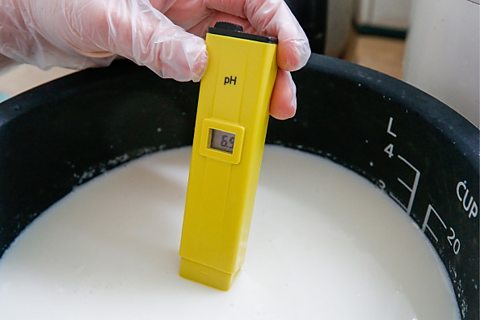
A pH meter gives a numerical value of the pH. As long as the pH meter has been looked after properly, the measurement should be accurateWhen a measurement is close to the true value (the actual value) being measured. . This means that the measurement is close to the true value.

Using an indicator
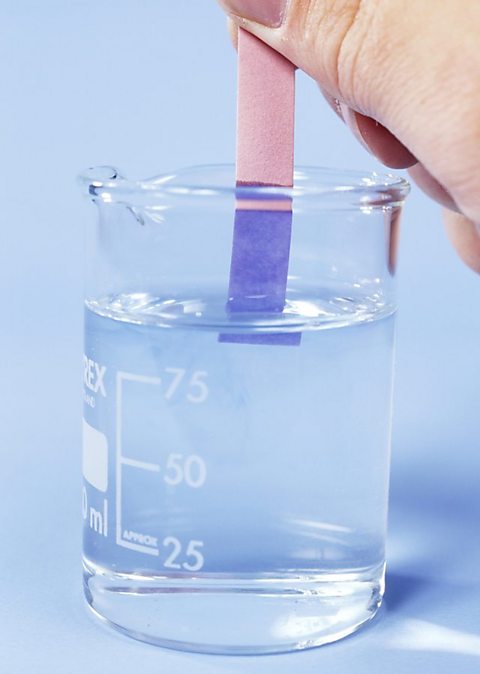
An indicator is a substance which will change colour depending on the pH of the solution it is mixed with. Some indicators are liquids, meaning we can add drops of the indicator to the solution being tested. Other indicators are strips of paper, and we can dip these into the solution.
Litmus is an example of an indicator. It turns red in solutions that are acidic and it is blue in alkaline solutions.
Universal indicator is a special indicator because it turns into a different colour at many different pH values. The colour of universal indicator at different pH values is shown further below.


Did you know?
Even red cabbage can be used as an indicator!

An indicator is added to a solution. It turns green. What is the pH of the solution?
It’s not possible to know. There are lots of different indicators and they give different colours at different pH values. Without the exact name of the indicator, it is not possible to know what the colour means.
If universal indicator was used then the pH would be 7 (neutral).

Using universal indicator
Universal indicator is supplied as a solution or as universal indicator paper. It is a mixture of several different indicators. Unlike litmus, universal indicator can show us how strongly acidic or alkaline a solution is, not just that the solution is acidic or alkaline. This is measured using the pH scale, which runs from pH 0 to pH 14.
Universal indicator has many different colour changes, from red for strongly acidic solutions to dark purple for strongly alkaline solutions. In the middle, neutral pH 7 is indicated by green.

When using universal indicator paper, we get more accurate results by putting only a small spot of the test solution on the paper, and then leaving the colour to develop for about 30 seconds before comparing it with the colour chart.
A few drops of universal indicator are added to water. Then some lemon juice is squeezed in. What colour change would happen?
Lemon juice is acidic (approximately 2 on the pH scale), so the water would change colour from green to yellow/orange.
Making an indicator
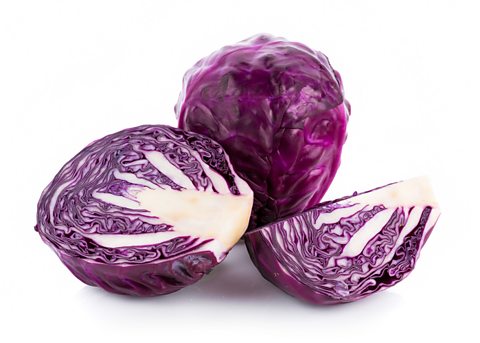
Lots of highly coloured vegetables and flowers can be used to make indicators just by mashing them in hot water. Red cabbage is one of the best, and can be compared to the colour charts above.
Other good natural indicators are beetroot, tea, turmeric and blackberries.
To make your own indicator, you will need:
- Red cabbage
- A kettle and water
- Household substances to test, such as lemonade, vinegar, baking powder or toothpaste. These are your substance samples.

- Chop up the red cabbage into small pieces and place it in a mug.
- Add freshly boiled water from the kettle.
- Stir the cabbage and boiling water until a deep purple solution is made.
- Put drops of your substance sample onto a white plate and then add your red cabbage solution.
- Use the colour comparison chart to find the pH of your substances.
Working scientifically
Write a short conclusion for your experiment - make sure you refer back to your results. Is red cabbage a good indicator?
Here's a hint for writing your conclusion…
If the different samples changed the colour the way you expected, then that shows that your experiment went well and red cabbage is a good indicator. It gave a range of colours with different substances.
If the colours did not change, can you work out what went wrong? Try the experiment again and check what happened at each step.

Find out more about how to conclude and evaluate your work in this guide.
Test your knowledge
Working safely in the lab
Find out how to spot risks, hazards and understand hazard symbols

More on Acids and alkalis
Find out more by working through a topic
- count2 of 3

- count3 of 3
